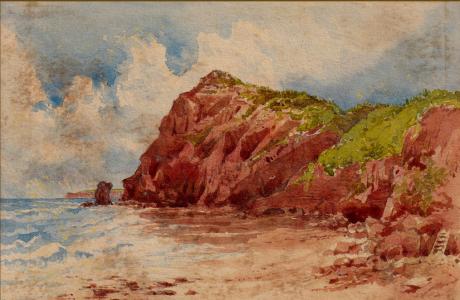inscribed and dated on the mount "The Peak" Sidmouth 1900"
Peak Hill was acquired by the National Trust in 1986 due to the outstanding generosity of Miss Anne Farewell Jones, and as a result of a joint appeal by Sid Vale Association and the Trust. The cliff face of Peak Hill is part of the Jurassic Coast which stretches from Orcombe Point, near Exmouth to Old Harry Rocks near Studland- 95 miles in distance. There is a continuous sequence of Triassic, Jurassic and Cretaceous rock formations spanning approximately 185 million years of history.
The prominent pointed shape of High Peak can be seen ahead and to the right. This was the location of a prehistoric hill fort and was later occupied during the Roman period and in the Dark Ages.On the edge of the cliff there are the remains of significant earthworks, which have been variously shown as having Iron Age, Roman and Dark Age occupation. Geological study, and the lines of the earthworks suggest that the site once extended several tens of metres into what is now eroded away. General interpretation suggests that it was an Iron Age defensive site which saw re-use in the Dark Age period, perhaps as a coastal trading station.
Beyond High Peak the coastal panorama stretches over the western end of the Jurassic Coast towards the mouth of the River Exe and then beyond to Dawlish, Teignmouth and Torbay. Within the cliffs below Peak Hill and High Peak a number of very rare fossils of Triassic fish, reptiles and amphibians have been found.
There are 3 distinct layers of rock in the Peak Hill cliff face. The Mercia Mudstone (various mudstones, siltstones and sandstones) form the base of the Peak Hill. They were deposited about 200 Million years ago in the hot dry climates of the Triassic Period. Above these, in the centre of the cliff face, are layers of Upper Greensand, that were deposited about 80 Million years ago. The top of Peak Hill is underlain by flint gravel, the remains of an original cover of chalk about 60 to 65 Million years ago.


